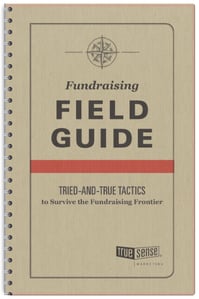
The Emotional Journey: Harnessing Human Behavior

Consider the caveman.
Against the flickering light of a fire, he uses gestures and sounds to convey information about the day’s victorious hunt: communication in its earliest stirrings. These gestures and sounds were how early humans made sense of the world before their capacity for speech was fully developed. The caveman didn’t know it, but he constantly altered how he communicated based on the responses he received.
That’s exactly what good fundraising should do.
Neuroscience has made great strides in identifying why we behave and respond the way we do. For example, it’s well-documented that being kind is good for you, because it releases oxytocin — a neurochemical that promotes trust and bonding. It stands to reason that when people are charitable, they’re rewarded by their feel-good hormones. That positive neurobiological feedback causes them to want to do more of the same behavior and therefore repeat their charitable actions.
This is important for fundraisers, because knowing what supporters are primed to respond to gives us an advantage when creating our fundraising strategies and messages.
To do that, consider developing the 5 Ps of donor marketing:
- Personas: Articulating Motivation
Personas are borne from one of the cardinal rules of marketing: Know your audience.
Historically, personas have been used to provide a demographic profile of different consumers. The goal? Create a representative persona out of the data to better market to those same types of people.
But savvy fundraisers know donors are so much more than data. The motivations that convince a prospect to become a donor — or compel a donor to become more deeply engaged — are multilayered and complex. It’s our job as fundraisers to tap into these motivations. Personas can help you do that.
Just developing your donor personas? Let our donor research studies help you get started. - Pillars: Structuring Messaging
Your organization has pillars — and not just the structural kind! Pillars are the overarching themes that trigger motivations for giving.
Think about the pillars you might have. If you’re a veterans’ organization, your pillars could be patriotism or gratitude. If you’re a food bank, one of your pillars could be community.
One of the best ways to figure out what your pillars are is to look through your most successful fundraising appeals and isolate the big themes. What are the broad ideas that correspond with your brand’s voice and incite action in your donors?
You might even conduct a focus group with donors and staff to discover which pillars are most commonly suggested.
Once you have identified your pillars, develop a single sentence to describe the essence of each pillar. Then, edit that sentence. Refine it until it’s ready to use as a thematic spine for your offers and messaging. - Position: Anchoring the Point-of-View
When fundraising is done best, the messaging is all about the donor. Campaigns rarely work well when they are all about the organization. Your fundraising appeals should answer one question for the donor: “What’s in it for me?”
Donors are not financial assets. They are heroes who should be credited with the humanitarian outcomes to which they connect.
Donors are the ones responsible for solving a problem. They can help turn something bad into something good. They are the ones to thank for a life saved, an animal adopted, a veteran helped, or a child fed.
By connecting donors to outcomes and potential outcomes, you provide positive reinforcement, which habituates donors to giving — so they can help solve more problems. - Persuasion: Finding the Balance
To be successful, marketers must be experts in persuasion. They need to form a convincing case to consumers about why they should buy a certain product. That may sound easy, considering the benefits of a product are usually tangible (for example, cleaner clothes, whiter teeth, or healthier snacks).
Charities must do the same kind of persuading, but often for reasons beyond tangible benefits. That makes it a harder sell in many ways. And that’s why tapping into human behavior and motivation is so important.
One of the best ways to create persuasive campaigns is to create messaging that balances the “creative equation”: Resonation of mission promise (outreach) and the demonstration of brand promise (outcome).
What does that look like?
For many organizations, the emotion often resides in the power of storytelling (a hungry child with a rumbling belly, for example), while the offer provides the tangible solution and emotional benefits ($25 provides 100 meals, fills an empty tummy, and floods the donor with feel-good hormones for making that happen).
Look for stories, and tell them persuasively. Pair those with offers that provide a good deal for the donor, and you have the base recipe for a persuasive appeal! - Preference: Offering Choices
When was the last time you liked being told what to do? Most people have an intrinsic resistance to being given orders.
Donors are no different. Offering choices in how and when they give is vitally important to creating a relationship with them — one that moves them from being transactional supporters to higher-value, transformational ones.
When you offer donors a choice, what you’re really telling them is that they are in control of their giving. You can make sure you’re telling donors their preferences are an important part of their identity as a supporter for your organization by letting them transact in their preferred channels and frequency. Ask them for their preferences! Nothing is more important than listening to what your donors are saying … except, perhaps, acting on it. Send surveys to get valuable feedback. Call donors to thank and connect with them. Listen to what they have to say, and honor their choices.
Remember the caveman from the start of this post? In the Paleolithic era, the focus of the caveman was to find food. They were hunter-gatherers — early humans who moved from place to place in search of the best hunting grounds. They were forced to adapt and evolve, and that came about, in part, through how they told their clan the story of their next move.
Fundraising is evolving, too. With more and more charities and channels vying for donor attention, it’s more important than ever to recognize what makes donors tick. Develop the 5 Ps, and you’ll be well on your way to connecting donors with a cause they are passionate about supporting: yours.
 This is an excerpt from our Fundraising Field Guide.
This is an excerpt from our Fundraising Field Guide.
Fundraisers have long sought to find and cultivate those with heroic human hearts who want to turn their compassion into action. Along the way, fundraisers have also learned lessons, honed skills, and crafted techniques that — in the end — are framed by basic human behaviors and motivations.
Get your copy of the complete compendium of tried-and-true tactics for conquering the fundraising frontier, written by TrueSense Marketing’s fundraising experts.
